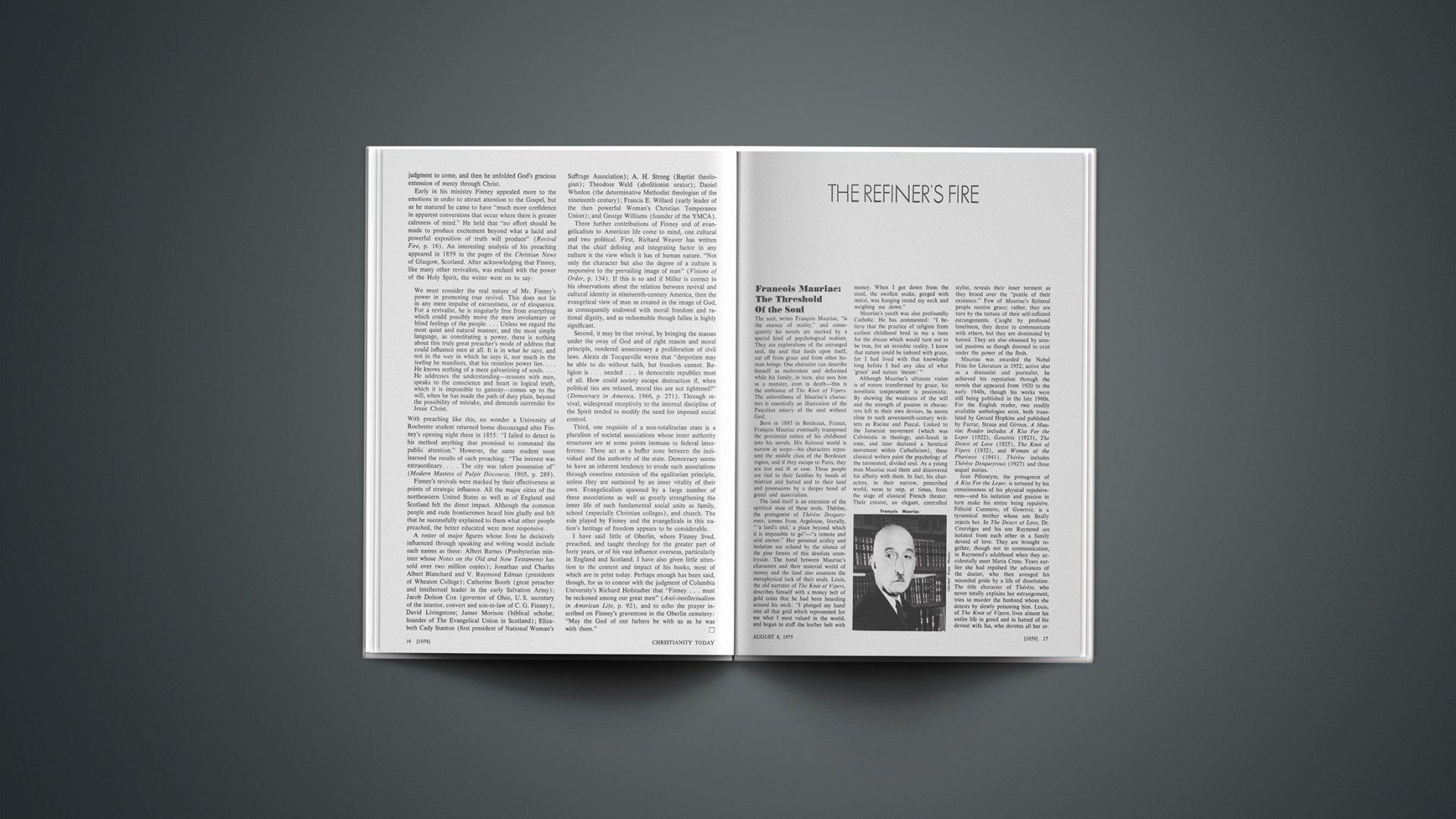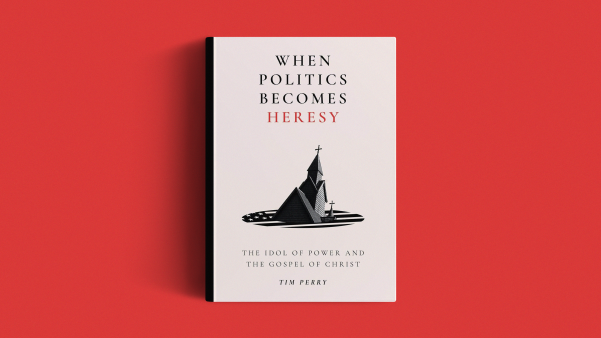Francois Mauriac: The Threshold Of The Soul
The soul, writes Francois Mauriac, “is the essence of reality,” and consequently his novels are marked by a special kind of psychological realism. They are explorations of the estranged soul, the soul that feeds upon itself, cut off from grace and from other human beings. One character can describe himself as malevolent and deformed while his family, in turn, also sees him as a monster, even in death—this is the ambiance of The Knot of Vipers. The unloveliness of Mauriac’s characters is essentially an illustration of the Pascalian misery of the soul without God.
Born in 1885 in Bordeaux, France, François Mauriac eventually transposed the provincial milieu of his childhood into his novels. His fictional world is narrow in scope—his characters represent the middle class of the Bordeaux region, and if they escape to Paris, they are lost and ill at ease. These people are tied to their families by bonds of mistrust and hatred and to their land and possessions by a deeper bond of greed and materialism.
The land itself is an extension of the spiritual state of these souls. Thérèse, the protagonist of Thérèse Desqueyroux, comes from Argelouse, literally, “ ‘a land’s end,’ a place beyond which it is impossible to go”—“a remote and arid corner.” Her personal aridity and isolation are echoed by the silence of the pine forests of this desolate countryside. The bond between Mauriac’s characters and their material world of money and the land also counters the metaphysical lack of their souls. Louis, the old narrator of The Knot of Vipers, describes himself with a money belt of gold coins that he had been hoarding around his neck: “I plunged my hand into all that gold which represented for me what I most valued in the world, and began to stuff the leather belt with money. When I got down from the stool, the swollen snake, gorged with metal, was hanging round my neck and weighing me down.”
Mauriac’s youth was also profoundly Catholic. He has commented: “I believe that the practice of religion from earliest childhood bred in me a taste for the dream which would turn out to be true, for an invisible reality. I knew that nature could be imbued with grace, for I had lived with that knowledge long before I had any idea of what ‘grace’ and nature ‘meant.’ ”
Although Mauriac’s ultimate vision is of nature transformed by grace, his novelistic temperament is pessimistic. By showing the weakness of the will and the strength of passion in characters left to their own devices, he seems close to such seventeenth-century writters as Racine and Pascal. Linked to the Jansenist movement (which was Calvinistic in theology, anti-Jesuit in tone, and later declared a heretical movement within Catholicism), these classical writers paint the psychology of the tormented, divided soul. As a young man Mauriac read them and discovered his affinity with them. In fact, his characters, in their narrow, prescribed world, seem to step, at times, from the stage of classical French theater. Their creator, an elegant, controlled stylist, reveals their inner torment as they brood over the “puzzle of their existence.” Few of Mauriac’s fictional people receive grace; rather, they are torn by the torture of their self-inflicted estrangements. Caught by profound loneliness, they desire to communicate with others, but they are dominated by hatred. They are also obsessed by sensual passions as though doomed to exist under the power of the flesh.
Mauriac was awarded the Nobel Prize for Literature in 1952; active also as a dramatist and journalist, he achieved his reputation through the novels that appeared from 1920 to the early 1940s, though his works were still being published in the late 1960s. For the English reader, two readily available anthologies exist, both translated by Gerard Hopkins and published by Farrar, Straus and Giroux. A Mauriac Reader includes A Kiss For the Leper (1922), Genetrix (1923), The Desert of Love (1925), The Knot of Vipers (1932), and Woman of the Pharisees (1941). Thérèse includes Thérèse Desqueyroux (1927) and three sequel stories.
Jean Péloueyre, the protagonist of A Kiss For the Leper, is tortured by his consciousness of his physical repulsiveness—and his isolation and passion in turn make his entire being repulsive. Félicité Cazenave, of Genetrix, is a tyrannical mother whose son finally rejects her. In The Desert of Love, Dr. Courrèges and his son Raymond are isolated from each other in a family devoid of love. They are brought together, though not to communication, in Raymond’s adulthood when they accidentally meet Maria Cross. Years earlier she had repulsed the advances of the doctor, who then avenged his wounded pride by a life of dissolution. The title character of Thérèse, who never totally explains her estrangement, tries to murder the husband whom she detests by slowly poisoning him. Louis, of The Knot of Vipers, lives almost his entire life in greed and in hatred of his devout wife Isa, who devotes all her attention to her children. And Brigitte Pion, the “woman of the Pharisees,” a self-appointed agent of righteousness, embodies hypocrisy and perfectionism as she destroys the people around her.
Of this group of characters, only the last two are touched by grace, but their illuminations come too late to change the general imprints left by their lives. Only Louis’s granddaughter can appreciate the old man’s change of heart and the hypocrisy of the Catholicism of his family. Although Brigitte’s stepson concludes that “she understood at last that it is not our deserts that matter but our love,” this moral statement seems the least satisfactory denouement of Mauriac’s major works, for Brigitte, also, remains isolated in her final years.
A sense of lost purity, of the vanished innocence of childhood, dominates Mauriac’s adult characters. They find human “love”a deception—a delusion that in the end separates and inflicts suffering. His adolescents also find an initial love experience deceiving, but their sensitivity and loneliness have not yet hardened into the cruelty of adulthood. The power of Mauriac’s stark, simple portrayal of the ugly reality of the human soul lies in his usually unexpressed suggestion that we all seek an experience of transcendent love and grace. The granddaughter says of Louis, in The Knot of Vipers, that “since he died I have seen much of people who, in spite of all their faults and weaknesses, live according to their faith and move about their daily tasks in the fullness of Grace. If Grand’pa had lived among them, mightn’t he have discovered years ago the harbour which he reached at last only on the very threshold of death?”
PATRICIA WARD1Patricia Ward teaches French and comparative literature at the Pennsylvania State University, University Park.
‘Rollerball’: Who Will Follow?
Toccata and Fugue in D minor for organ by J. S. Bach dramatically opens the futuristic film Rollerball, released by United Artists, produced and directed by Norman Jewison (Jesus Christ Superstar). For here is another film about a saviour.
Jonathan E., played by James Caan, is the star of the Houston, Texas, rollerball team. The game is a vicious combination of roller derby, hockey, and muggings. Players include seven skaters and three motorcyclists. Since war no longer exists, rollerball provides a release for the hostility and violence of both players and spectators. The world is run by the corporations of Energy, Luxury, Transport, Food, Housing, and Communications.
Jonathan’s popularity, strength, and individuality—the latter something we are told rather than shown—have become a threat to the Energy corporation. (Everything in the year 2018 looks sterile and mass-produced. Even the women all look alike.) Therefore corporation executive Bartholomew, intently portrayed by John Houseman, tells him to retire. Bartholomew says, “It’s a significant game, but not a game a man is to grow strong in.”
Even though Jonathan has played the rugged game for a decade, he, too, is passive and flat. But like a struggling moth breaking loose from a cocoon he resists the corporation’s order, though admitting he doesn’t know why. His life, dedicated to making goals in the game, is without goals off the track.
Since the executives don’t dare to kill Jonathan, they try to eliminate him by changing the rules of the game, until no time limits, penalties, or substitutions are allowed. Of course he survives, the only one to do so during the world championship game. The film moves predictably to a non-ending—Jonathan triumphantly skating around and around and.…
Jonathan E. is trying to save the world from its mass-hypnotic state. He alone fights the corporation system. One reviewer said that he shakes society to its roots, but the film ends before we see that happen. Instead, Jonathan just continues his circular skate around the arena. He and we may see him as saviour, but saviour of what? Or for whom? Everyone loves him, but those who know he’s been asked to retire think he’s wrong to resist the rules. These people like their lives; they don’t want them changed. Society is lulled and coddled, divided into executives, rollerball players, and their women, who function only as sexual machines, and the mindless masses who rhythmically chant “Jon-a-than, Jon-a-than” at games.
Rollerball takes us one step farther than the anti-hero. It shows us a hero without a cause, a saviour without disciples willing to follow.
CHERYL FORBES










